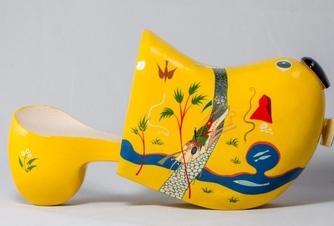Volodarsk
It is well worth making the trip to the Volodarsk district for its incredible nature.
Chernorechye territory covering the villages of Zhelnino, Seyma and Pushkino has been historically called the Yalta of Nizhny Novgorod, where you can take a walk and breathe the fresh air, while the real pearl of the area is the unbelievably colorful Bugrov cottage. We have put together a guide to the Volodarsk district, where you can go for the weekend.
A FEW FACTS
WHAT TO DO IN THE CITY
01
Go for a walk at the summer cottage of the merchant Bugrov
The cottage of the bread manufacturer Nikolai Bugrov is a real fairytale «gingerbread» house. Thanks to Bugrov, many buildings constructed in Volodarsk are still in use today. To take just a couple of examples, Bugrov hosted the writer Maxim Gorky and the «grandfather of Russian industrialization» Sergei Witte at this country cottage. Built in the Russian style, the cottage is decorated with carvings and platbands, and is a real architectural treasure of the Nizhny Novgorod region. Unfortunately, the interiors have been completely lost to posterity. However, there is a museum center now where you can learn about the merchant's life, examine artefacts from archaeological excavations, and take a tour or a master class.
02
Visit the memorial room of the composer Boris Mokrousov
The famous Soviet composer Boris Mokrousov, known for his songs «Sormovskaya Lyrical», «The Lonely Accordion» and «Vologda», spent his childhood years in the village of Krasnaya Gorka in the Volodarsk district. You can still find his house here and learn about his life and work with help of a small exhibition at the Reshetikha Hall of Culture, where the interior is recreated in the style of the middle of the last century, complete with the composer’s actual belongings, including books, furniture, chinaware, and musical instruments.
03
Stop by the St Nicholas Church
There is also a church in Reshetikha, built in 1900 in the style of the ancient Russian church architecture of the XVII century, with bulbous domes and arched elements. The walls inside the church are decorated with ornaments and paintings depicting biblical themes.
04
Go for a walk in Chernorechye
The territory of Chernorechye in the Volodarsk district, also known as the Yalta of Nizhny Novgorod, was a favorite vacation spot for the clerisy at the turn of the XIX and XX centuries. The beauty of the local pine forests, and the meadows and banks of the Oka, was noted by Gorky and Korolenko, to give just two examples. Decide the route for yourselves, but head in the general direction of Zhelnino-Pushkino-Seima.
05
Take a look around the ruins of the merchant's estate
The ruined estate complex of the merchant Bashkirov, built in the 1860s and located in a pine forest, is in a sorry state, but in its grounds, you can still see the remains of the main house and the icehouse, as well as the water tower, which of all the features here has been preserved best to the present day.
06
Take a trip to the Florishchi Monastery
In the old times, deserted and remote places where Christian ascetics found shelter and solitude were known as «deserts». Now there is a monastery here, built in the monumental style, which was founded in the middle of the XVII century on the Florishcheva Krasnaya Gora, from which, according to legend, a radiant light once emanated. This prophetic sign indicated the special purpose of this place for spiritual life. Many buildings, such as the Cathedral of the Assumption of the Mother of God, the Trinity Church, and the Bell Tower, were built back in the 1670s-1680s.
07
Book a horseback ride
The Harmony Equestrian Club offers horse riding classes for children and adults, and you can also ride in a large horse-drawn cart or arrange a photo shoot with the animals.
08
Visit St Basil's Church
One of the district’s most spectacular churches can be found in the village of Myachkovo. It was built in the early XX century in the Russian style, with eclectic elements on the site of the former Vasiliev Monastery that was originally founded in 1352.
09
Buy yourself a Reshetikha bell shoe
The wooden Reshetikha bell shoe is one of the main souvenirs of the district: its painting depicts the history and legend of the place where the Seymovsky confluence was created. In the origami-like packaging, you can find an insert recounting the «Legend of the Shoes». Each bell is hand-painted by Palekh artists, and the founder of this art project is the designer Rustam Adyukov. Be on your guard, though, these trinkets don’t come cheap, at around 6 500 rubles a piece.



























